#peter gansevoort
Explore tagged Tumblr posts
Text



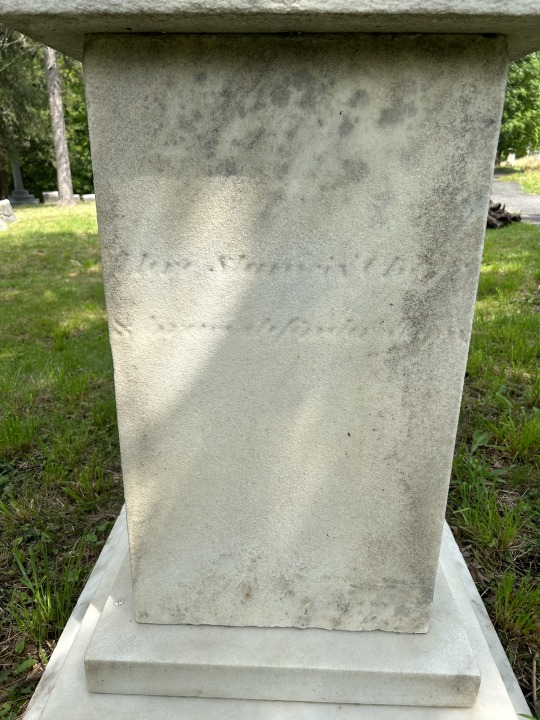
I visited family near Albany this weekend, and while exploring a historic cemetery I stumbled across a RevWar general, and one who features prominently in my future 5th Revolution book set during the Siege of Fort Schuyler (Stanwix). I only noticed it because I thought, "that stone looks old, oh it says 1777 and there's a flag, I should go look!"
The inscriptions read:
He served under Montgomery in Canada in 1775 In 1777 defended Fort Stanwix against St. Ledger thereby preventing his junction with Burgoyne and died in active command at the beginning of the war of 1812
To the memory of Peter Gansevoort Junior a Brigadier General in the army of the United States who died on the 2nd day of June 1812 aged 62 years 11 months and 16 days
Here Stanwix chief and brave defender sleeps
And the side for his wife:
Catherine van Schaick wife of Peter Gansevoort Jr. Died Dec. 30 1830 aged 78 years 4 months and 14 days [I think]
#albany rural cemetery#accidental research trip#my aunt got to hear a lot about history she probably didn't care about#peter gansevoort#revwar#american revolution#amwriting historical fiction#histfic#history is all around you
5 notes
·
View notes
Text
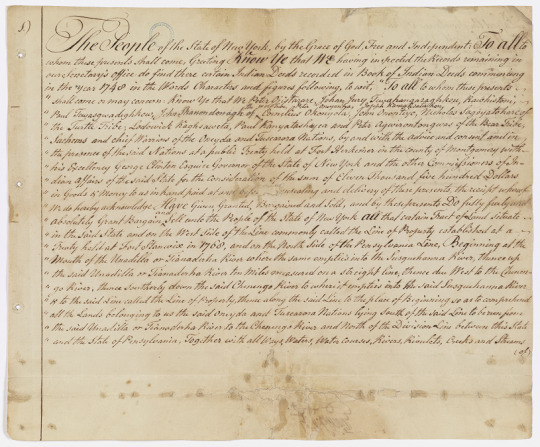


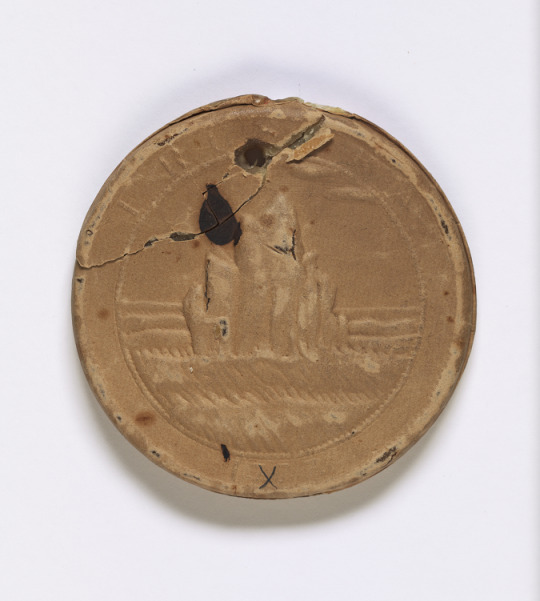
Ratified Indian Treaty 19A (first and last pages), April 11, 1793.
This treaty with the Six Nations (Seneca, Cayuga, Onondaga, Oneida, Mohawk, and Tuscarora) included this wax Great Seal of the State of New York.
Record Group 11: General Records of the United States Government
Series: Indian Treaties
Image description: A circular seal, just over three inches in diameter, made of wax covered with paper. Depicted in the center is a sun with a face, rising over hills. Below the hills is “EXCELSIOR”. Around the border of the seal is “THE GREAT SEAL OF THE STATE OF NEW YORK”. There is a hole through the seal at the top.
Image description: Reverse of the circular seal. In the center are spiky rocks jutting out of the water. There are letters at the top of the border, but it’s difficult to see what they say. At the bottom of the seal is an ink “X”. There is a hole through the seal at the top.
Transcription:
1)
The People of the State of New York, by the Grace of God, Free and Independent: To all to
whom these presents shall come, Greeting Know ye that We having inspected the Records remaining in
our Secretary's Office do find there certain Indian Deeds recorded in Book of Indian Deeds commencing
in the year 1748 in the Words Characters and figures following, to wit, "To all to whom these presents
"shall come or may concern: Know ye that We Peter Ojistarare, Johan Jesry Towahangaraghkou, Rawhistoni,
"Paul Tewasgwadeghkow, John Skanondonagh of the wolf tribe, Peter Oneyanha, Joseph Kanaghsaterhon, Cornilius Okonyota, John Onontiyo, Nicholas Sagoyatokare of
"the Turtle Tribe; Lodowick Kaghsaweta, Paul Kanyatashayea and Peter Agwirontongwas of the Bear Tribe,
"Sachems and chief Warriors of the Oneyda and Tuscarara Nations, by and with the advice and consent and in
"the presence of the said Nations at a public Treaty held at Fort Herkimer in the county of the Montgomery with
"his Excellency George Clinton Esquire Governor of the State of New York and the other Commissioners of In-
"dian Affairs of the said State for the consideration of the sum of Eleven Thousand five hundred Dollars
"in Goods & Money to us in hand paid at and before [illegible] ensealing and delivery of these presents, the receipt whereof
"We do hereby acknowledge Have Given, Granted, Bargained and Sold, and by these presents Do fully freely and
"Absolutely Grant Bargain and Sell unto the People of the State of New York all that certain Tract of Land situate
"in the said State and on the West Side of the Line commonly called the Line of Property established at a
"Treaty held at Fort Stanwix in 1768, and on the North Side of the Pensylvania Line, Beginning at the
"Mouth of the Unadilla or Tianaderha River where the same empties into the Surquchanna River, thence up
"the said Unadilla or Tianaderha River ten Miles measured on a straight line, thence due West to the Chenen-
"go River, thence Southerly down the said Chenengo River to where it empties into the said Sasquchanna River
"& to the said Line called the Line of Property, thence along the said Line to the place of Beginning so as to comprehend
"all the Lands belonging to us the said Oneyda and Tuscarora Nations lying South of the said Line to be run from
"the said Unadilla or Teanaderha River to the Chenengo River and North of the Division Line between this State
"and the State of Pensylvania, Together with all Ways, Waters, Water courses, Rivers, Riverlets, Creeks and Streams
(of)
[page 2]
16.)
"Onaakaronton his x mark LS Tehoghweakaronto his x mark LS Kaghnunrayen his x mark LS Agwirontong-
"waghs his x mark LS Anonghsighraghtha his x mark LS Oniatariyoo his x mark LS Kaneyaggh his x mark
"LS Geo: Clinton LS Pierre Van Cortlandt LS Ezra L Hommedieu LS Abm Ten Broeck LS Peter Gansevoort-
"Junr. LS Richd. Varick LS Witnesses Present Sam Kirkland Missry. Interpreter John Lansing Junr. Jos.
"Brant, David Hill, John Tayler, Malachi Treat, Abm Hardenbergh, Peter Otsiequette, Aghwistonisk his x mark,
"Oneyanka his x mark, Coll. Honyery his [mark] mark, Oneida Chiefs. Onangaiekhon his x mark, Fhoghnawayen
"x Senekas. - Be it Remembered that on the Twenty fifth day of November in the year one thousand seven hundred and
"ninety one before me John Sloss Hobart one of the Justices of the Supreme Court of the State of New York came Samuel Kirkland,
"Clerk, Missionary and Interpreter to the Six Nations of Indians, who made oath that he was present and did see the Twenty
"-Eight Sachems, Chiefs and Warriors of the Onondaga Nation of Indians whose names are written opposite to their respec-
"tive Seals severally seal and deliver the within written Ratification as their Voluntary act and deed for the purposes and uses therein mentioned,
"he having previously thereto faithfully and truly interpreted the Contents of the same from the English into the Indian Language unto the said
"Sachems, Chiefs and Warriors in such a manner that it was fully understood by them and that he also saw the Commissioners on the part of the
"State of New York in the said Ratification Mentioned severally seal and deliver the same as their Voluntary act and deed for the purposes and
"uses therein mentioned, and that John Lansing Junr. and the Eleven other persons whose names are signed as Witnesses were present and did see
"the said parties Seal and deliver the said Ratification; and I having Examined the same and found no material alteration therein do al-
"low it to be recorded Jno. Sloss Hobart. The preceding Instrument refers to the Treaty recorded in pages 150 & which is dated the 12th.
"of September 1788, and is a true copy of the Original, Examined and compared therewith this 5th. day of April 1793 (the words "alias Land Car-
"rier" in page 170 being interlined) By me Robert Harpur D Secry."
~~~~~~~~
All which WE have caused to be Exemplified by these Presents: In Testimony whereof
We have caused these our Letters to be made patent and the Great Seal of our said State to be hereunto affixed Witness
our Trusty and well beloved George Clinton Esquire Governor of our said State General and Commander in chief
of all the Militia and Admiral of the Navy of the same, at our City of New York; this Eleventh day of April in the year of
our Lord one thousand seven hundred and Ninety-Three, and in the Seventeenth year of our Independence.~
#archivesgov#April 11#1793#1700s#Early America#Native American history#American Indian history#Indigenous American history#Iroquois Confederacy#Seneca#Cayuga#Onondaga#Oneida#Mohawk#Tuscarora#New York#Indian treaties
77 notes
·
View notes
Photo

This Week in History: Siege of Fort Schuyler
At about this time in 1777, the British siege of Fort Schuyler crumbles. You won’t believe what Benedict Arnold—not yet a traitor—did to finally bring that 3-week siege to an end. Earlier attempts to rescue the besieged Americans had fallen apart. Notably, Brigadier General Nicholas Herkimer’s rescue effort had gone awry when he and his men got sidetracked by the bloody Battle of Oriskany. Herkimer won, but at great cost. (See August 5 history post.) Meanwhile, Fort Schuyler’s commander, Peter Gansevoort, was left to fend for himself. You won’t be surprised to hear that he wasn’t one to give up! When British Lieutenant Colonel Barry St. Leger demanded his surrender, he defiantly refused. He told St. Leger that he was “determined to defend [the fort] to the last extremity, against all enemies whatsoever, without any concern for the consequences of doing his duty”! The British spent the next two weeks firing at the fort. They diverted the local water supply so as to deprive those in the fort of water. And they began digging trenches that enabled them to move closer and closer to Fort Schuyler. But they had another problem on their hands. The story continues here: https://www.taraross.com/post/tdih-siege-fort-schuyler
#this week in history#history#history blog#america#American Revolution#benedict arnold#today i learned#sharethehistory
7 notes
·
View notes
Photo
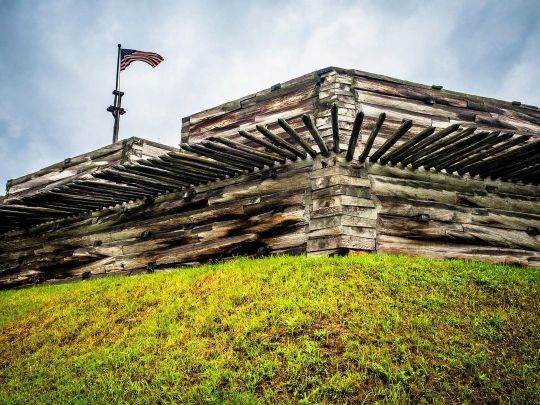
Happy Birthday to Fort Stanwix National Monument! @fort.stanwix.nps #OTD in 1976, Fort Stanwix opened to the public (having been created as a monument in 1935) and has been sharing the stories of this region for 46 years. ❓ ❓ ❓ Fort Stanwix (also known as Fort Schuyler) sits on a trail that connected the Mohawk River and Wood Creek, used for thousands of years by the Six Nations Confederacy of the Mohawk Valley. Fort Stanwix played a vital role in the expansion of this region and rich resources it contains, as well as the hold the stories of the Seneca, Cayuga, Onondaga, Oneida, Mohawk, and Tuscarora nations. ⭐️ ⭐️ ⭐️ "Known as "the fort that never surrendered," Fort Stanwix, under the command of Col. Peter Gansevoort, successfully repelled a prolonged siege, in August 1777, by British, German, Loyalist, Canadian, and American Indian troops and warriors commanded by British Gen. Barry St. Leger. The failed siege combined with the battles at Oriskany, Bennington, and Saratoga thwarted a coordinated effort by the British in 1777, under the leadership of Gen. John Burgoyne, to take the northern colonies, and led to American alliances with France and the Netherlands. Troops from Fort Stanwix also participated in the 1779 Clinton-Sullivan Campaign and protected America's northwest frontier from British campaigns until finally being abandoned in 1781." - nps.gov/fost ���: Fort Stanwix National Monument, NY 📅 : July 2017 #IBrakeForBrownSigns #nationalparkgeek #RecreateResponsibly ........................................ (at Fort Stanwix National Monument) https://www.instagram.com/p/Ca-ORjzpcER/?utm_medium=tumblr
2 notes
·
View notes
Text
AH and Matthew Clarkson, again
See my Clarkson post1 post2 post3. My investigation into Clarkson began because JCH wrote the following (LAH, vol 7):
At [AH’s] bedside [on his deathbed] were his wife and children - the grieving clergy - his tearful physician - and his much-beloved Clarkson.
We also know from a letter from Clarkson to King that AH requested that Clarkson be with him.
Yet Clarkson is not mentioned anywhere that I’ve come across as one of AH’s closest friends, even though there is evidence (see post2 again) of prior knowledge of the duel, conversations with EH, and concern for the Hamilton children after AH’s death. One of the reasons for this may be the lack of surviving letters between AH and Clarkson. In mature adulthood, they also were usually both in NY, so it’s not clear how many letters there ever were. (As an aside, Robert Troup at times hung out with AH every day in the late 1790s - in law practice together, but still - why not speculate on this as AH’s most intimate friendship, Chernow?!)
The new part: I found the remainder of the letter of Matthew Clarkson to AH, 20Aug1798, with the part that’s not on Founders:
New York August 20th 1798
Dear Sir
I have reflected maturely on our conversation of yesterday. The result is, as far as I can with propriety I decline, at present, any military appointment. The duty I owe my Family seems to demand this of me, nor can I believe I give too great weight to this consideration when I consider the very small probability there is of any serious military operations taking place in this Country and the real injury I should sustain by being called from my present pursuits [remaining text not included on Founders] These however are my reflections, if they are wrong, counsel me otherways, at any rate believe me with the greatest Regard & Esteem
Dear Sir
Yours very Sincerely
M. Clarkson
This does change the tone of the letter, from a formal rejection of an appointment to a more congenial “tell me if I’m wrong” informality (including the ending). Check out the original page here.
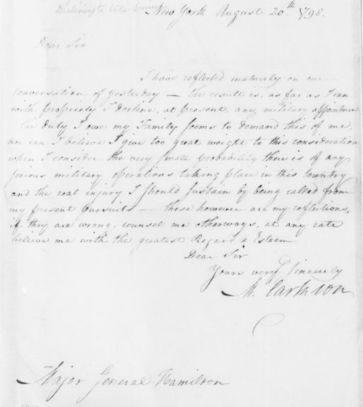
Below is text of a letter from John Jay (married to Clarkson’s first cousin, Sarah L. Jay, Sarah and Matthew’s mothers’ were French sisters) to GW, encouraging GW to appoint Clarkson as Marshall of the District of NY (he does) (13Mar1791):
...I take the Liberty of communicatg my sentiments respecting a Gentleman who too delicate to display his own merit, possesses more than falls to the Share of many—I mean General Matthew Clarkson.1 I think him one of the most pure & virtuous Men I know—when at Boston General Lincoln (whose aid he was) spoke to me of him in Terms not only of Approbation but affection—During the war he was a firm & active Whig, and since the Peace a constant Friend to rational and good Government. Few men here of his standing enjoy or deserve a greater Degree of the Esteem & goodwill of the Citizens than he does, and in my opinion he would discharge the Duties of that or any office for wh. he may be qualified with Propriety and Honor.
What else have I not included yet - Clarkson was at Yorktown (under Gen. Lincoln). I already speculated in the prior post that because Clarkson was William Livingston’s nephew, he and AH could have known each other as early as 1773. They’re certainly around the same people all of their lives thereafter.
Here’s the politicalgraveyard.com summary for Clarkson (helpful to have some of the relatives listed!)
Clarkson, Matthew (1758-1825) — of New York, New York County, N.Y. Born in New York, New York County, N.Y., October 17, 1758. General in the Continental Army during the Revolutionary War; member of New York state assembly from New York County, 1789-90; member of New York state senate Southern District, 1793-95; president, Bank of New York, 1804-25. Died in New York, New York County, N.Y., April 25, 1825 (age 66 years, 190 days). Burial location unknown.
Relatives: Son of Elizabeth (French) Clarkson (1724-1808) and David Clarkson (1726-1782); married, May 25, 1785, to Mary Rutherfurd (1767-1786); married, February 14, 1792, to Sarah Cornell (1761-1803); great-grandson of Anthony Brockholls and Phillip French; second great-grandfather of Peter Augustus Jay; first cousin of Henry Brockholst Livingston; first cousin once removed of Matthew Clarkson (1733-1800) and William Jay; first cousin twice removed of John Jay II; first cousin thrice removed of Charles Ludlow Livingston; first cousin four times removed of Brockholst Livingston; second cousin once removed of James Jay and Frederick Jay; third cousin of Jeremiah Van Rensselaer, Robert Van Rensselaer and James Livingston; third cousin once removed of Robert R. Livingston, Edward Livingston, Peter Robert Livingston (1766-1847), Jacob Rutsen Van Rensselaer, Philip Jeremiah Schuyler, Maturin Livingston and Peter Gansevoort; third cousin twice removed of Philip Schuyler, James Alexander Hamilton, Peter Robert Livingston (1789-1859), Gerrit Smith and Elizabeth Cady Stanton; third cousin thrice removed of John Jacob Astor III and Cortlandt Schuyler Van Rensselaer. Political families: Livingston-Schuyler family of New York; Roosevelt family of New York City, New York (subsets of the Three Thousand Related Politicians).
#Matthew Clarkson#Alexander Hamilton#John Jay#Sarah L. Jay#William Livingston#and then I read all of post1 again and realized I actually quoted the whole Clarkson#letter correctly there#oh well
20 notes
·
View notes
Photo

Fort Gansevoort
A Look Back: 50 Years After Stonewall
OPENING: Thursday, 11. July 2019 | 6-8pm
Exhibition: July 11 - August 10 2019
5 Ninth Avenue, New York, NY 10014
www.fortgansevoort.com A Look Back: 50 Years After Stonewall Fort Gansevoort presents A Look Back: 50 Years After Stonewall, organized by Lucy Beni and Adam Shopkorn. The exhibition commemorates the fiftieth anniversary of the 1969 Stonewall Uprising, a six-day riot said to have been spontaneously set off by Marsha P. Johnson in protest of one of many regular police raids at The Stonewall Inn, a gay bar located in New York City’s Greenwich Village. This event marks the beginning of the Gay Liberation movement and the contemporary fight for LGBTQ+ rights in the United States. A Look Back: 50 Years After Stonewall unites the work of queer artists living and producing in and around New York City beginning around the time of the Stonewall Uprising in 1969 and leading into the 1980s. This is only a portion of the story, an incomplete history, most especially given that the Gay Liberation movement and its coinciding contemporary art market had not placed transgender voices nor people of color at the forefront of the conversation. Featured artists in the exhibition include Joan E. Biren, Jimmy DeSana, Rotimi Fani-Kayode, Flloyd, Efrain John Gonzalez, Barbara Hammer, Harmony Hammond, Lyle Ashton Harris, Peter Hujar, Thomas Lanigan-Schmidt, Greer Lankton, Tom Lohre, Kate Millett, John Simone, Nelson Sullivan, Paul Thek, Paula Gately Tillman, David Wojnarowicz, Martin Wong among others. Also included in the exhibition is ephemera such as pride and protest buttons, Tee Corinne’s 1975 Cunt Coloring Book, and the 1970s lesbian newspaper The Furies. Above Image: Paula Gately Tillman, Nelson Sullivan, 1986, Gelatin silver print. Courtesy, Fales Library, NYU.
11 notes
·
View notes
Photo
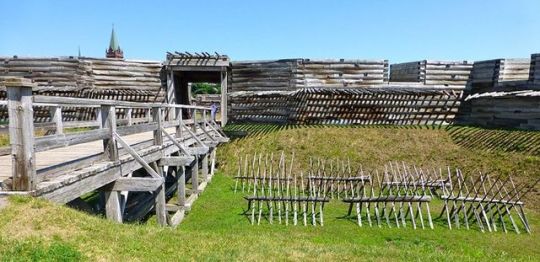
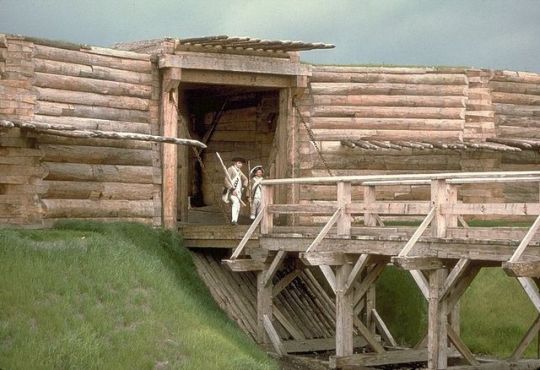
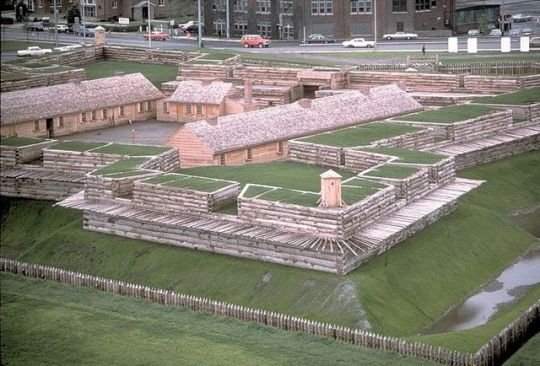
Fort Stanwix.
Fort Stanwix was constructed in 1758 to guard a portage between the main waterway southeastward to the Atlantic seacoast, down the Mohawk and Hudson rivers, and an important interior waterway northwestward to Lake Ontario, down Wood Creek and Oneida Lake to Oswego.
In 1768, Fort Stanwix was the site of an important treaty conference between the British and the Iroquois, arranged by William Johnson. By the time of this treaty, the fort had become dilapidated and inactive. The purpose of the conference was to renegotiate the boundary line between Indian lands and white settlements set forth in the Proclamation of 1763. The British government hoped a new boundary line might bring an end to the rampant frontier violence, which had become costly and troublesome. Indians hoped a new, permanent line might hold back white colonial expansion.
The final treaty was signed on November 5 and extended the earlier proclamation much further west. The Iroquois had effectively ceded Kentucky to the whites. However, the tribes who actually used the Kentucky lands, primarily Shawnee, Delaware, and Cherokee, had no role in the negotiations. Rather than secure peace, the Fort Stanwix treaty helped set the stage for the next round of hostilities.
Fort Stanwix was abandoned in 1768 and allowed to go to ruin.
The fort was reoccupied by Colonial troops under the command of Colonel Elias Dayton on July 12, 1776. They began reconstruction and renamed it Fort Schuyler, although many continued to call it Fort Stanwix. Colonel Peter Gansevoort took over command of the fort on May 3, 1777.
On August 3, 1777, the fort was besieged by The King's 8th Regiment of Foot, Loyalists, and Indians, under the command of Brigadier General Barry St. Leger, as part of a three-pronged campaign to divide the American colonies. Gansevoort refused the terms of surrender offered by the British, and the siege commenced.
According to local folklore, when the Colonial troops raised the flag over the fort on August 3, 1777, it was the first time that the Flag of the United States was flown in battle. It is more likely that the flag flown at Fort Schuyler was one that consisted only of thirteen stripes, an early version of the Flag of New York, or the Grand Union Flag.
The Battle of Oriskany was fought a few miles away when an American relief column, led by General Nicholas Herkimer, was ambushed by Tories and their Indian allies. While many of the besiegers were attending to that battle, the defenders of the fort sallied forth and attacked the enemy camp, looting and destroying enemy stores. Demoralized and reduced in strength, the British withdrew when they heard reports of the approach of yet another relief column, led by General Benedict Arnold. The British forces withdrew through Canada and joined Burgoyne's campaign at Fort Ticonderoga.
The British failure to capture the fort and proceed down the Mohawk Valley was a severe setback and helped lead to the defeat of General John Burgoyne at the Battle of Saratoga.
In April 1779, an expedition from Fort Schuyler against the Onondaga people was begun by the Continental Army led by Col. Goose Van Schaick.
The fort burned to the ground on May 13, 1781 and was not rebuilt. It was abandoned and the garrison took up quarters at Fort Herkimer.
A second Treaty of Fort Stanwix was conducted at the fort between the Americans and the Indians in 1784. During the War of 1812 a blockhouse was built on the parade ground. Beginning in 1828 the fortifications were dismantled.
The fort was designated a National Monument on August 21, 1935. Between 1974 and 1978 the National Park Service reconstructed the fort; a new visitor center was added in 2005. The monument is currently open year around, operated by the National Park Service.
#fort stanwix#seven years war#French and indian war#star fort#history#military history#American history#british army#American revolution#revwar#American war of independence#war of 1812
249 notes
·
View notes
Note
Dear ARCHatlas, I’m visiting Philadelphia and New York where would you recommend visiting?
We have Philadelphia and Pennsylvania on separate feature posts and posted extensively about art and architecture of Philadelphia. We have posted numerous times about New York City including this feature post.
I will take this opportunity to feature six recent NYC projects that merit a visit:

World Trade Center Transportation Hub Santiago Calatrava

High Line Diller Scofidio + Renfro, James Corner Field Operations and Piet Oudolf

The Whitney Museum of American Art at Gansevoort Renzo Piano Building Workshop + Cooper Robertson

Fulton Center Grimshaw

National September 11 Memorial Handel Architects with Peter Walker

VIΛ 57 West BIG
234 notes
·
View notes
Photo

An Incomplete History of Protest: Selections from the Whitney’s Collection, 1940–2017. Exhibition closes Aug 27, 2018. X Through the lens of the Whitney’s collection, An Incomplete History of Protest looks at how artists from the 1940s to the present have confronted the political and social issues of their day. Whether making art as a form of activism, criticism, instruction, or inspiration, the featured artists see their work as essential to challenging established thought and creating a more equitable culture. Many have sought immediate change, such as ending the war in Vietnam or combating the AIDS crisis. Others have engaged with protest more indirectly, with the long term in mind, hoping to create new ways of imagining society and citizenship. X ARTISTS IN THE EXHIBITION John Ahearn* Emma Amos Rudolf Baranik Andrea Bowers Mark Bradford AA Bronson Paul Burlin Andrew Castrucci* Paul Chan and Badlands Unlimited Mel Chin Larry Clark Sue Coe* William N. Copley Allan d'Arcangelo Bruce Davidson Richard Deagle* Jane Dickson* Louis H. Draper Melvin Edwards Chris "Daze" Ellis* Larry Fink Vincent Gagliostro* Ja'Tovia Gary Theaster Gates General Idea Jeffrey Gibson John Giorno* Leon Golub Felix Gonzalez-Torres Avram Finkelstein Hermine Freed Gran Fury Nancy Grossman Group Material* Guerrilla Girls Keith Haring Hock E Aye VI Edgar Heap of Birds Charles B. Hinman Jenny Holzer* Rashid Johnson Mary Kelly Edward Kienholz Barbara Kruger* Suzanne Lacy Annette Lemieux Glenn Ligon Fred Lonidier Daniel Joseph Martinez John "Crash" Matos* Josephine Meckseper Julie Mehretu* Toyo Miyatake Donald Moffett* Peter Moore Frank Moore* Robert Morris Senga Nengudi Louise Nevelson Gordon Parks Irving Petlin Howardena Pindell Carl Pope Ad Reinhardt Marlon Riggs Faith Ringgold Tim Rollins and K.O.S. Kay Rosen* Martha Rosler Dread Scott Gary Simmons Jaune Quick-to-See Smith Jack Sonenberg Nancy Spero* Tom Starace* May Stevens Carol Summers Mierle Laderman Ukeles* Kara Walker Joseph Wolin* Martin Wong* Adja Yunkers *Installed as part of an earlier version of the exhibition. X Whitney Museum of American Art 99 Gansevoort Street New York, NY 10014 (212) 570-3600 @cutinthefence
3 notes
·
View notes
Photo

What to Wear Wednesdays with BCD! “This week we feature ‘The King of Corsetry’ @petersoronen whom I had the honor of working with since 2000 as an Evening Wear Specialist for @barneysny Rest In Peace. One of my dear clients, Sharon Foster Burdick shared an equal fondness for Peter and he was her go to for any special occasion including dinner 🍽 at the @whitehouse with President and First Lady Bush. After launching my company @blanecharlesdesign in 2009, I was able to bring my clients directly to Peter Soronen’s Atelier. Peter and I collaborated for @diffanational ‘Dining by Design’ 2013 for ‘Diner in Le Boudoir de Madame’ making us the first designers to feature a dining room in a French woman’s boudoir in Paris, France. And I had the pleasure of spending a weekend at Peter’s country home and blogged about the blurred lines between fashion & interiors ‘At Home with Peter Soronen. Peter is a one man show that does things his way and as a fellow independent entrepreneur, I am inspired and empowered to have him as a friend!” - BCD ________________________________________________________ •The Real Real https://www.therealreal.com/designers/peter-soronen •At Home With PETER SORONEN https://elementsoffierce.wordpress.com/2011/06/13/at-home-with-peter-soronen/ •Virtual Tour of DIFFA 2013 Diner in le Boudoir de Madame by our product designer, Adeline Olmer http://youtu.be/GMhcHWmChUU ____________________________________________ #BCD #BecomeaDiamond #stylish #Motivationalmonday #Transformationtuesday #Whattowearwednesday #Throwbackthursday #Flashbackfriday #Fridayfeeling #Fridayflow #Postive #Instamood #Social #Swag #Beautiful #Creativecontent #Nothingisordinary #Seeksimplicity #Smallbizw #Businessowner #Goals #Namaste #Wellbeingwarrior #Fashionable (at Gansevoort Meatpacking NYC) https://www.instagram.com/p/CCrvHPDlW-K/?igshid=pu7cf4quo90q
#bcd#becomeadiamond#stylish#motivationalmonday#transformationtuesday#whattowearwednesday#throwbackthursday#flashbackfriday#fridayfeeling#fridayflow#postive#instamood#social#swag#beautiful#creativecontent#nothingisordinary#seeksimplicity#smallbizw#businessowner#goals#namaste#wellbeingwarrior#fashionable
0 notes
Text
Inside Out and Upside Down
In the hot weeks of June 2008, patrons of New York restaurant Florent stuffed their pockets with matches, postcards and other ephemera emblematic of the 24-hour diner soon to close, “beloved in equal measure by celebrities on the A list and hedonists on the edge.” [1] The matches that were struck by both Calvin Klein and meatpackers from the factory down the street were designed by M & Co, the graphic and product design consultancy founded by the acclaimed Tibor Kalman.
Each of the three Florent matchbooks in Cooper Hewitt’s collection is inked with one simple illustration of a restaurant necessity: a fork, a water glass, and a saltshaker. The black line graphic on dense, speckled brown paper (M & Co wanted the matchbook printed inside out, with the coated paper on the inside and cardboard on the out, vexing every printer they approached) is both inconspicuous and intriguing, like the restaurant itself.
In 1986, Florent Morellet put his first name in the window of an old luncheonette on Gansevoort Street and began serving ‘French bistro meets American classic’ fare, from hamburgers and steak frites to onion soup and chili. Located in the now unrecognizable Meatpacking District, one that predates the upscale shops and the weekender tourists, Florent was the destination for those who tended to work at night: club-goers and artists. Here was where Diane von Furstenberg would dine when downtown. Roy Lichtenstein ate there every day, always in the same back corner seat, where Morellet eventually hung a map of Liechtenstein as designation.[2] Creative types were not foreign to the French expat, whose father was the conceptual painter, sculptor, and light artist François Morellet.
As far as his establishment’s design, Morellet kept much of the décor from the 1950s diner—the stools, the tile, the Formica tables—and left the graphics to Tibor Kalman and M & Co. In exchange for their work, the employees of M & Co were fed by Florent four days a week, from 1985 to 1993.[3]
Kalman’s matchbooks are humble but not reductive, depicting everyday dining ephemera in miniature. They are icons for the essentials; his design is witty for its obviousness and on-brand for a restaurant owner who cursed out (albeit good-naturedly) a reporter after he gave his restaurant press. The romantic idea of discovery by happenstance or insiders’ word of mouth is also embedded in the M & Co matchbook design: when all the matches are pulled—in other words, 20 cigarettes later—the establishment’s address is fully revealed against a smooth, bright primary color background. Other M & Co print campaigns for Florent left out its address and telephone number deliberately.
“I’m always trying to turn things upside down and see if they look any better,” said Kalman. In a shape shifting city like New York, it is inside-out matchbooks and upside-down designs that keep it grounded.
[1] Bruni, Frank. “Genre-Bending Hangout Takes Its Final Bows.” The New York Times, May 21, 2008. Accessed August 11, 2017. http://ift.tt/2ieb1id.
[2] Ibid.
[3] Hall, Peter, and Michael Bierut, eds. Tibor Kalman, Perverse Optimist. Princeton Architectural Press, 2000.
Greta Rainbow is the Peter A. Kreuger intern in the Department of Communications & Marketing at Cooper Hewitt, Smithsonian Design Museum.
from Cooper Hewitt, Smithsonian Design Museum http://ift.tt/2uOP6VW via IFTTT
1 note
·
View note
Photo

This Week in History: A Little-known Revolutionary War Hero
At about this time in 1749, Revolutionary War hero Peter Gansevoort is born. But for him, would Americans have lost the Battle of Saratoga? He held an important fort at a critical moment, sidetracking British reinforcements that might otherwise have shown up at that battle. The American victory at Saratoga was important: It encouraged the French to join the war as our allies. Little is known about Gansevoort’s early years, although we know that he had (at best) limited military experience when the American Revolution began. That didn't stop him from joining the Continental Army in 1775. Nevertheless, he is best remembered for something that he did two years later: He refused to surrender Fort Schuyler to the British. In August 1777, British Lt. Colonel Barry St. Leger was working his way past Fort Schuyler, then commanded by Gansevoort. St. Leger’s ultimate goal was to rendezvous with General John Burgoyne, then on a campaign to isolate the New England colonies from the others. Fort Schuyler stood in St. Leger’s way. He laid siege to it in early August. The story continues here: https://www.taraross.com/post/tdih-peter-gansevoort
#tdih#otd#this day in history#history#history blog#American Revolution#Revolution#liberty#freedom#sharethehistory
7 notes
·
View notes
Photo

It’s #thinksmallparks week over on @hellorangerusa with @nationalparkgeek! Those of you who know me, know I LOVE smaller parks! ⠀⠀ ⠀ “For thousands of years the ancient trail that connects the Mohawk River and Wood Creek served as a vital link for people traveling between the Atlantic Ocean and Lake Ontario. Travelers used this well-worn route through Oneida Indian territory to carry trade goods and news, as well as diseases, to others far away. When Europeans arrived they called this trail the Oneida Carrying Place and inaugurated a significant period in American history--a period when nations fought for control of not only the Oneida Carrying Place, but the Mohawk Valley, the homelands of the Six Nations Confederacy, and the rich resources of North America as well. In this struggle Fort Stanwix would play a vital role.⠀ ⠀ Known as "the fort that never surrendered," Fort Stanwix, under the command of Col. Peter Gansevoort, successfully repelled a prolonged siege, in August 1777, by British, German, Loyalist, Canadian, and American Indian troops and warriors commanded by British Gen. Barry St. Leger. The failed siege combined with the battles at Oriskany, Bennington, and Saratoga thwarted a coordinated effort by the British in 1777, under the leadership of Gen. John Burgoyne, to take the northern colonies, and led to American alliances with France and the Netherlands. Troops from Fort Stanwix also participated in the 1779 Clinton-Sullivan Campaign and protected America's northwest frontier from British campaigns until finally being abandoned in 1781.” - nps.gov⠀ ⠀ 📍: Fort Stanwix National Monument, New York @fort.stanwix.nps⠀ 📅 : July 2018⠀ ⠀ #unitedbynature⠀ #IBrakeForBrownSigns ⠀ #nationalparkgeek ⠀ #findyourambassador⠀ (at Fort Stanwix National Monument) https://www.instagram.com/p/CFb4WoTgBhd/?igshid=1q48vwzuopazt
1 note
·
View note
Link
To celebrate its 20th birthday, global sneaker and streetwear retailer Sneakersnstuff (SNS) has announced the opening date for its Los Angeles flagship store location, followed by collaborations, custom releases, the SNS New York bar opening, and a phone app dedicated to making sneaker buying and collecting seamless.
Founded in Stockholm on March 26, 1999, Sneakersnstuff was originally conceptualized as a small local store for the sneaker-obsessed community in Sweden by Erik Fagerlind and Peter Jansson. The brand has since evolved into a multi-city footprint, global brand with retailers in Stockholm, Paris, Berlin, London, New York, and opening this month in Los Angeles.
Driven by an ethos of inclusivity and being locally connected, Sneakersnstuff partners with the best in class creatives, artists, local influencers and crews in all cities around the world to create innovative opportunities, events and platforms to continue the fashion conversation amongst like-minded communities. Sneakersnstuff prides itself in creating a unique approach to design and architecture across all brand details from the stores, offices and collaborations. Custom details throughout each storefront are inspired by local and heritage elements of each country and neighborhood where a store exist while integrating custom builds. These are imperative moments for the brands to highlight the integrity of Sneakersnstuff and partners of the brand.
For its 20th anniversary, Sneakersnstuff will host an array of activities throughout the year. The first launch of 2019 will commence on its birthday, March 26, 2019, with the official opening of the Sneakersnstuff LA store. Located on the Venice Beach Boardwalk and designed by Sneakersnstuff and Jenny Askenfors of Bofink Design, the space is inspired by the history and legacy of Venice. From the founders’ obsession with Venice, Italy, the oil drilling history of Venice, CA, to championing the Mexican heritage and overall culture of the West Coast, the Sneakersnstuff store pays homage to all of the elements which make Los Angeles, primarily Venice, special. Outside of being a premium sneaker destination, the space will serve as a hub for events, activations, community work, engaging with local creatives, artists, branded store experiences.
Following the SNS Los Angeles opening will be the retailer’s second global hospitality venue under the Sneakersnstuff umbrella, the SNS Bar, in May 2019. The SNS Bar is located in a beautiful space underneath the Sneakersnstuff NYC store (22 Little West 12th Street, NY), with entry being through an incredible staircase located on the Gansevoort Street side. The bar is owned and will be programmed out by Sneakersnstuff, and operated by Andreas Bergman and Joel Söderbäck – the founders of award-winning cocktail bars and restaurants, Tjoget, listed as one of the world’s top 50 bars, and Paradiso in Stockholm.
The SNS Bar will unite customers, community and friends of the brand for an abundant selection of cocktails, music curation and programming five days a week. In addition to public availability, the SNS Bar provides availability for private events. The SNS Bar was first introduced in December 2017 where the space hosted the brand’s NYC store afterparty with a surprise performance by Nas.
Streaming through the 20th anniversary year with more announcements and surprises. The retailer’s new mobile app will cement Sneakersnstuff as the fairest destination to obtain limited edition sneakers while elevating the experience with editorial content and offering future gamification opportunities. The Sneakersnstuff app and new website will launch in spring 2019.
#sneakersnstuff#sneaker blog#sneaker stores#sneakerheads#sneaker community#streetwear blog#fashion blog
0 notes
Text
Durex Condoms Has Hilarious Response To About Spider-Man Leaving MCU
Durex Condoms Has Hilarious Response To About Spider-Man Leaving MCU
Durex, a company which specializes in condoms, is the latest to weigh in on Spider-Man leaving the Marvel Cinematic Universe. The news that Kevin Feige would no longer be involved in producing Spider-Man movies, and that Tom Holland’s Peter Parker would no longer appear in any titles for the MCU, has led to a diverse set of reactions from fans and from people within the industry. But what might…
View On WordPress
0 notes